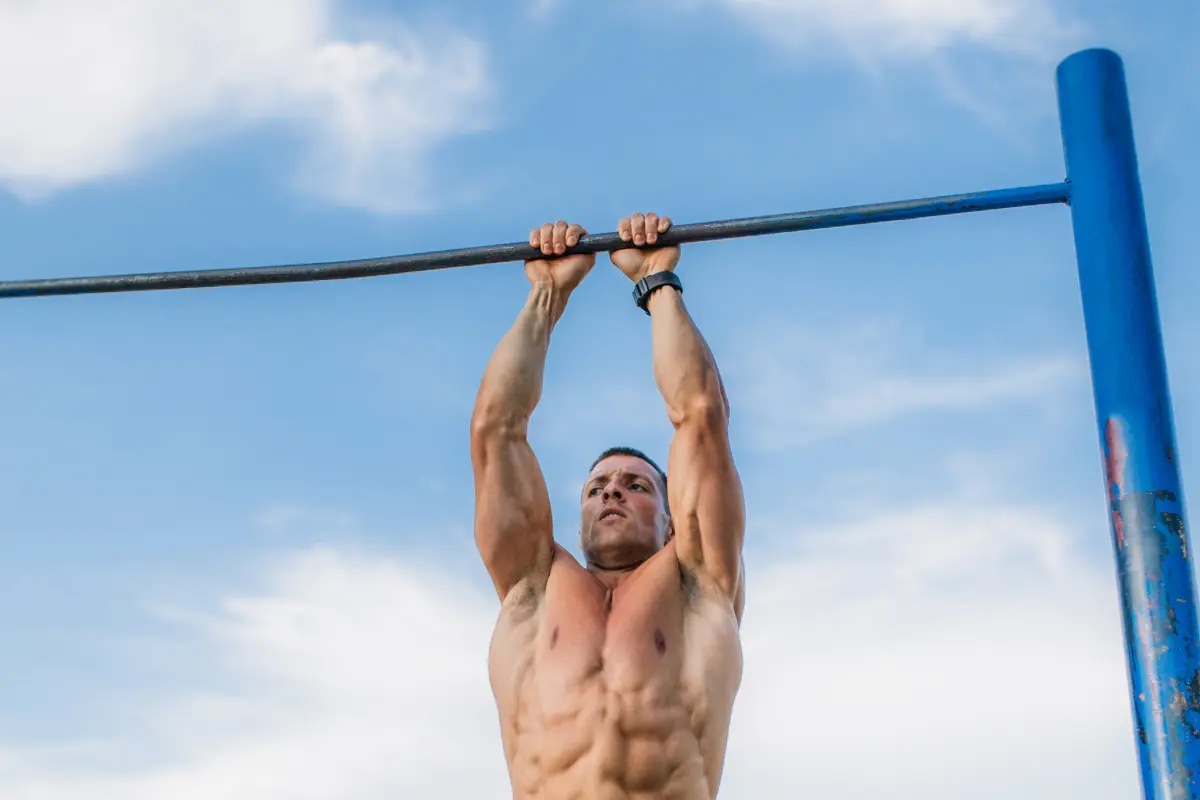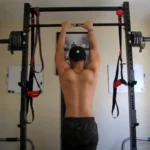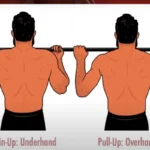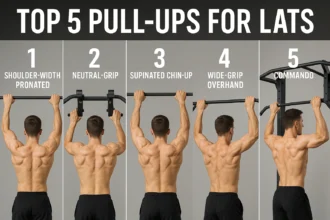Narrow grip pull-ups are a highly effective variation of the traditional pull-up that specifically target the upper body, focusing on the biceps and upper back muscles. This guide will explore the technique, benefits, variations, and tips for incorporating narrow grip pull-ups into your fitness routine.
What are Narrow Grip Pull-Ups?
Narrow grip pull-ups are performed with your hands placed closer together—typically about shoulder-width or less—on a pull-up bar. This grip alters the muscle activation pattern compared to wider grip variations, placing more emphasis on the biceps and inner lats.
Muscle Groups Targeted
- Primary: Latissimus Dorsi, Biceps Brachii
- Secondary: Brachialis, Brachioradialis, Trapezius, Rhomboids
- Tertiary: Erector Spinae, Forearm muscles
Narrow grip pull-ups primarily target the latissimus dorsi (lats) and biceps brachii due to the close hand positioning. When you pull yourself up, your lats engage as the primary movers, while the biceps act as strong secondary movers, significantly contributing to the lifting motion.
The narrow grip also heavily recruits the lower trapezius and rhomboids, promoting comprehensive upper back development. This variation can reduce stress on the shoulder joint compared to wider grips, potentially making it more comfortable for those with shoulder issues.
Additionally, it engages the forearms and grip muscles more intensely than standard pull-ups. The exercise also requires substantial core activation for stability throughout the movement.
Overall, narrow grip pull-ups offer a balanced approach to upper body development. This exercise can be performed using various equipment, such as a pull-up bar, gymnastic rings, or resistance bands, making it accessible for different fitness levels.
How to Perform Narrow Grip Pull-Ups
Performing narrow grip pull-ups correctly is essential for maximizing their benefits and minimizing the risk of injury. Follow these step-by-step instructions to master the technique:
Step-by-Step Instructions
- Set Up:
- Find a sturdy pull-up bar that can support your body weight. Ensure it’s at a height that allows you to hang freely without your feet touching the ground.
- Grip the Bar:
- Stand under the bar and reach up to grip it with your palms facing away from you (overhand grip). Position your hands shoulder-width apart or closer. Your grip should be firm but relaxed.
- Start Position:
- Jump or step up to grab the bar. Begin in a dead hang position with your arms fully extended, feet off the ground, and body straight. Engage your core to stabilize your body.
- Initiate the Pull:
- Begin the movement by pulling your elbows down towards your sides. Focus on using your back and biceps to lift your body upward.
- Pull Up:
- Continue to pull until your chin is above the bar. Aim to bring your chest close to the bar without swinging your body. Keep your shoulders down and back, avoiding excessive shrugging.
- Top Position:
- At the top of the movement, hold for a moment to maximize muscle engagement. Ensure your chin is clearly above the bar.
- Lowering Phase:
- Slowly lower your body back to the starting dead hang position. Control the descent to engage your muscles throughout the entire movement.
- Repeat:
- Perform the desired number of repetitions, maintaining proper form throughout. Focus on smooth, controlled movements rather than speed.
Tips for Proper Form
- Engage Your Core: Keep your core tight to prevent swinging and maintain stability.
- Avoid Momentum: Use your muscles to pull yourself up instead of relying on momentum or swinging your legs.
- Breathing: Exhale as you pull yourself up and inhale as you lower yourself back down.
- Full Range of Motion: Ensure you fully extend your arms at the bottom and pull your chin above the bar at the top for optimal muscle engagement.
Narrow Grip vs. Wide Grip Pull-Ups
Pull-ups are a staple in strength training, but the grip you choose—narrow or wide—significantly impacts muscle engagement and overall workout effectiveness.
Muscle Engagement
- Narrow Grip Pull-Ups:
Typically performed with hands placed shoulder-width apart or closer, narrow grip pull-ups emphasize the biceps more than the latissimus dorsi (lats). This grip allows for greater elbow flexion, leading to increased bicep activation, which is ideal for those looking to build arm strength and size. Additionally, the involvement of the pectoral muscles can enhance upper body strength.
- Wide Grip Pull-Ups:
In contrast, wide grip pull-ups engage the lats more intensely, targeting the upper back and contributing to a broader back development. The hands are placed wider than shoulder-width, which reduces bicep activation and requires more strength from the upper back muscles. This grip is excellent for achieving that coveted “V” shape in the back.
Performance and Difficulty
The difficulty of each variation can vary by individual. For many, wide grip pull-ups may feel more challenging due to the increased strain on the back and shoulders. This grip also requires a higher range of motion, which can be tough for those with less upper body strength or shoulder mobility.
Conversely, narrow grip pull-ups might be more accessible for beginners, as they place less stress on the shoulder joints.
Which Should You Choose?
Your choice depends largely on your fitness objectives:
- For Bicep Development: Opt for narrow grip pull-ups to maximize arm engagement.
- For Back Development: Choose wide grip pull-ups to target the lats and enhance back width.
- For Overall Strength: Incorporating both variations into your routine can provide balanced development across muscle groups.
Progressions for Narrow Grip Pull-Ups
If you’re struggling to perform narrow grip pull-ups or want to build strength progressively, consider these modifications:
- Assisted Pull-Ups: Use a resistance band or an assisted pull-up machine to reduce the amount of body weight you need to lift. Gradually decrease assistance as you gain strength.
- Negative Pull-Ups: Jump or use a step to get into the top position of a pull-up and then slowly lower yourself down. This eccentric training helps build strength for the upward phase.
- Isometric Holds: Hold the top position of the pull-up for as long as you can to build strength in the muscles used during the lift.
- Bodyweight Rows: Perform inverted rows using a bar set at waist height to develop the pulling muscles without the full weight of a pull-up.
- Lat Pulldowns: Use a lat pulldown machine with a narrow grip attachment to build the strength and movement pattern needed for pull-ups.
Programming and Integration of Narrow Grip Pull-Ups
Integrating narrow grip pull-ups into your workout routine can enhance upper body strength and muscle definition. Here’s how to effectively program them:
1. Frequency and Structure
- Workout Frequency: Aim to include narrow grip pull-ups 2-3 times a week, allowing for adequate recovery between sessions.
- Split Routine: Incorporate them into an upper-body split or a full-body workout, pairing with complementary exercises like push-ups, rows, or shoulder presses.
2. Repetition and Set Ranges
- Beginners: Start with 3 sets of 3-5 repetitions, focusing on form and control.
- Intermediate: Progress to 3-5 sets of 6-10 repetitions as strength improves.
- Advanced: Challenge yourself with 4-6 sets of 10-15 repetitions or add weight (using a dip belt or weighted vest) to increase difficulty.
3. Progression Techniques
- Assisted Pull-Ups: Use resistance bands or an assisted pull-up machine to build strength if full pull-ups are challenging.
- Negative Pull-Ups: Focus on the lowering phase to build eccentric strength.
- Isometric Holds: Hold the top position of the pull-up to increase strength and endurance.
4. Warm-Up and Cool Down
- Warm-Up: Include dynamic stretches for the shoulders, lats, and arms, such as arm circles and band pull-aparts, to prepare the muscles.
- Cool Down: Finish with static stretches focusing on the biceps, lats, and shoulders to improve flexibility and aid recovery.
5. Combination with Other Exercises
- Supersets: Pair narrow grip pull-ups with exercises like push-ups or dips to target different muscle groups and increase workout intensity.
- Circuit Training: Combine with other bodyweight or resistance exercises (e.g., rows, planks, squats) for a full-body workout.
6. Periodization
- Variety: Change the grip width, tempo (slow down the movement), or use different pull-up variations to prevent plateaus and maintain engagement.
- Cycle Focus: Incorporate cycles where you focus on narrow grip pull-ups for several weeks, followed by a phase emphasizing wide grip pull-ups to ensure balanced development.
Example Workout Routine
Upper Body Day:
- Warm-Up (5-10 minutes)
- Narrow Grip Pull-Ups: 3 sets of 6-10 reps
- Push-Ups: 3 sets of 10-15 reps
- Bent-Over Rows: 3 sets of 8-12 reps
- Dumbbell Shoulder Press: 3 sets of 8-10 reps
- Core Exercise (Plank or Hanging Leg Raises): 3 sets for 30 seconds to 1 minute
- Cool Down (5-10 minutes)
Conclusion
By carefully programming and integrating narrow grip pull-ups into your workout routine, you can maximize their benefits, build upper body strength, and promote balanced muscular development. Adjust the frequency, sets, and intensity based on your fitness level and goals, and don’t hesitate to mix in other exercises for a comprehensive training regimen.













